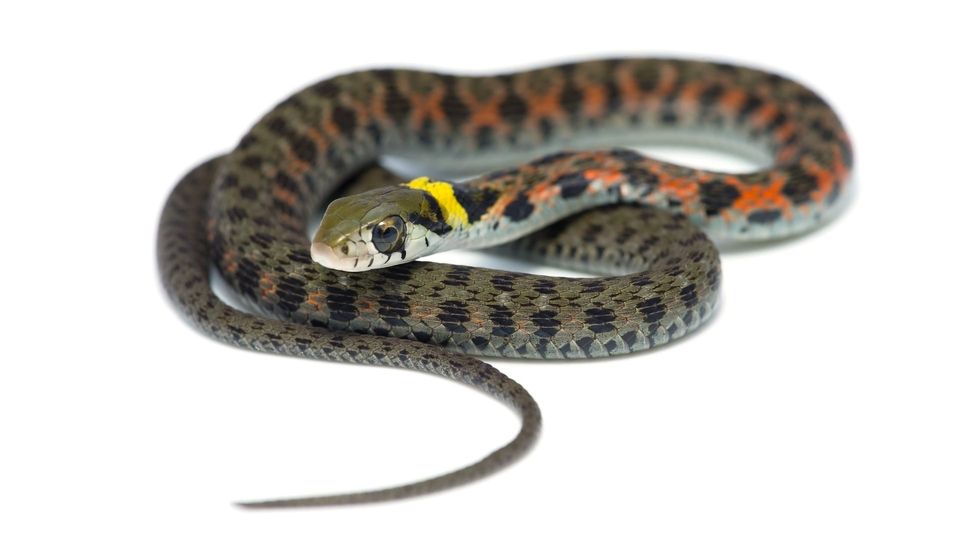Species which were evolved 320 million years ago are the longest living family of cold-blooded animals, i.e. reptiles.
The Aldabra giant tortoise, a reptile, has been recorded to live up to 150 years. One of the species from the class reptiles is a tiger keelback snake, Rhabdophis tigrinus. Also called kkotbaem, or yamakagashi, it is a venomous and poisonous snake from the family Colubridae and order Squamata.
Surprisingly, while the dorsal has a green and black color pattern below the neck, the first third of the snake's body has black and orange spots and crossbars.
The snakes have two nuchal glands in their necks that secrete a toxic secretion that is ingested by consuming poisonous toads and they often use them as a defense mechanism as the toxin (venom) scares away their predators.
They bite using venom-injecting fangs to subdue the prey or threat.
With Japan as its type locality, the Asian tiger keelback (Rhabdophis tigrinus) or Japanese tiger keelback, is a rear-fanged snake that is found in the Ryukyu Island in Japan, an island in Taiwan, Russia, China, Korea, and Vietnam. A subspecies of the snake is recorded in Taiwan, the Rhabdophis tigrinus formosanus.
If the uniqueness of the tiger keelback makes you interested to read more about similar species, you can read about anaconda snake and black racer.
Tiger Keelback Interesting Facts
What type of animal is a tiger keelback?
A tiger keelback, venomous and poisonous snake, is also known as kkotbaem and yamakagashi. The snake has two nuchal glands at the back of its neck which secrets toxic poison which is injected by the tiger keelback fangs at the rear of its mouth. The snake has two subspecies – Rhabdophis tigrinus tigrinus and Rhabdophis tigrinus formosanus.
What class of animal does a tiger keelback belong to?
The tiger keelback snake belongs to the class Reptilia, order Squamata, family Colubridae, and genus Rhabdophis. A tiger keelback that is poisonous and venomous possesses a toxin that is used as its defense mechanism to get away from its predator.
How many tiger keelbacks are there in the world?
Neither is the tiger keelback snake listed under the IUCN Red List of Threatened Species nor has its population been calculated. The species is considered to be at no risks except its predators. The search reports highlighted that the tiger keelbacks were first recorded 2.5 million years ago.
Where does a tiger keelback live?
The tiger keelback (Japan as its type locality) is usually found in Ryukyu Island in Japan, Russia, Island in Taiwan, South and North Korea, China, and Vietnam. While it is active in the summers from April to October, it hibernates for the rest of the year.
What is a tiger keelback's habitat?
The tiger keelbacks are found in fields, islands, near water, and mountainous areas. Also reports available reflect that the snakes are also found in and around forests ranging up to deciduous, and flooded plains, especially near their type location, Japan.
Who do tiger keelbacks live with?
The tiger keelbacks are usually found to live solitary lives.
The species of tiger keelback snakes are recorded to live with toads and frogs, ensuring the availability of sufficient food to feed upon and avoids residing near their predators as the snakes portray anti-predator responses which vary from flattening of its neck and body to secreting toxin or poison from its glands on the back of their necks.
How long does a tiger keelback live?
Like many animals from the class reptiles, the tiger keelback snakes are speculated to live long considerable lives but there is no estimated lifespan of the tiger keelback snake recorded so far.
How do they reproduce?
The search reports available have little information related to the reproductive behavior of the snakes. The tiger keelbacks are oviparous snakes. The reproduction in the snakes takes place around the summers as they hibernate from April to October.
The females lay up to 2-40 eggs. The eggs are laid by the females in late July-August, while eggs hatch into young offspring in August-September. The young snakes grow quickly and are recorded to attain sexual maturity within one to two years.
What is their conservation status?
The IUCN has listed these snakes' conservation status as Not Evaluated. While it is speculated that the population of the snakes is stable, predators are considered as one of the most common causes for tiger keelback death.
Tiger Keelback Fun Facts
What do tiger keelbacks look like?
This keelback with green-black and orange pattern has a varied colored first-third body. It has an orange dorsal with blackish-brown spots below the necks, while it has a bright yellow-colored underside and a white belly. The eyes are olive green in color.

We've been unable to source an image of a Tiger Keelback and have used an image of a Thamnophis elegans vagrans instead. If you are able to provide us with a royalty-free image of a Tiger Keelback, we would be happy to credit you. Please contact us at hello@kidadl.com.
How cute are they?
While the dorsal color pattern gets quite an attention, a closer look would lead to a life-threatening situation as the snakes could bite you if threatened.
How do they communicate?
While the exact communication method of the tiger keelback snakes is yet another mystery to be solved, it is speculated that since they live a solitary life, seldom do they need to converse with other animals.
On the contrary, snakes are known to convey the threat using different body movements like lying flat on the ground or secreting toxic poison-like secretions through their venom-absorbing glands.
How big is a tiger keelback?
A tiger keelback inhabiting Japan is 24-39 in (60-100 cm) long. It is five to six times smaller than the longest snake, i.e. reticulated python, which is as long as 5-21.3 ft (1.5-6.5 m).
How fast can a tiger keelback move?
The speed of the tiger keelback is yet to be found. While a black mamba is reported to be the fastest snake.
How much does a tiger keelback weigh?
The weight of the tiger keelback is not estimated so far.
What are the male and female names of the species?
The males and females do not have distinctive names based on their sex.
What would you call a baby tiger keelback?
While there is no scientific name related to a young snake, a baby tiger keelback is called a snakelet.
What do they eat?
The tiger keelback snakes feed upon small vertebrates. Toads and frogs are considered the primary prey of their diet. Toads and frogs consumed as a part of their diet are considered as the source of the deadly venom absorbed by the glands.
Are they poisonous?
Yes, the tiger keelback snakes are poisonous as well as venomous. The primary components of their diet – toads and frogs – they prey upon are a source of toxic poison absorbed by the venom-absorbing glands present at the back of their necks.
Would they make a good pet?
No, since their bite possesses venom – which is speculated to be quite dangerous as it can lead to breathing and other heart complications in humans – the snake does not make a good pet. The snake secreting toxic poison is better kept in wild. Also, it has a strong defense mechanism secreting a toxin through its nuchal glands.
Did you know...
The tiger keelbacks prey upon toads and frogs as they are considered one of the common dietary food.
The snakes have nuchal glands at the back of the neck which secret a tiger keelback poison called bufadienolides. Considering tiger keelback venom strength, they have a strong defense mechanism to fight against their predators.
The snakes are required to have a good defense system to ensure survival. The defense mechanism is inherited by the snakes through the maternal transfer of chemicals.
While tiger keelback snake bite treatment remains poorly studied, the humans bitten by tiger keelback are found to be at a risk due to arousal of breathing and other heart issues.
Japan is considered its most common location.
They are neither considered to have a healthy population nor are Endangered.
How did tiger keelbacks get their name?
The tiger keelbacks get their name due to the distinctive dorsal pattern.
What snake is both venomous and poisonous?
The snake secreting poison can be toxic and poisonous, but is not necessarily considered venomous. A snake with a proper mechanism to secrete the venom is considered venomous.
In the case of a tiger keelback, the snake is toxic and is poisonous. Also, it has glands at the back of its neck which absorb the poison toxin present in toads, a primary component of its diet, and secrets it through its fangs.
Here at Kidadl, we have carefully created lots of interesting family-friendly animal facts for everyone to discover! Learn more about some other reptiles from our scarlet snake facts and gopher snake facts for kids pages.
You can even occupy yourself at home by coloring in one of our free printable Tiger keelback coloring pages.
*Please note that the main image is of an olive keelback, not a tiger keelback. If you have an image of a tiger keelback, please let us know at hello@kidadl.com.










